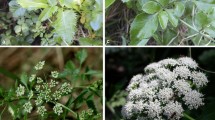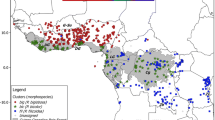Abstract
This study investigates the genetic differentiation within the Central European Armeria maritima (Mill.) Willd. complex with special reference to the metallicolous populations using AFLP markers. Our sampling comprised all metallicolous (ssp. halleri, hornburgensis, bottendorfensis, eifeliaca, calaminaria), and non-metallicolous taxa (ssp. maritima, elongata, alpina). Geographical and genetic distances between populations were moderately positively correlated. Genetic variability of metallicolous and non-metallicolous populations was not significantly different. Lowland populations were clearly differentiated from the alpine populations. Within the lowland group metallicolous and non-metallicolous populations were not genetically differentiated. All lowland populations show a regional differentiation and close relationships to ssp. elongata. Thus, the metallicolous taxa should not be maintained as subspecies. Likewise, their treatment as varieties of a ssp. halleri s.l. is critical because this taxon cannot be consistently characterized throughout its geographical range and may be an artefact itself. If a taxonomical recognition should be considered necessary it is advisable to treat the microendemics as varieties of ssp. elongata.
Similar content being viewed by others
References
Baker HG (1966). The evolution, functioning and breakdown of heteromorphic incompatibility systems. I. The Plumbaginaceae. Evolution 20: 349–368
Baumbach H (2005) Genetische Differenzierung mitteleuropäischer Schwermetallsippen von Silene vulgaris, Minuartia verna und Armeria maritima unter Berücksichtigung biogeographischer, montanhistorischer und physiologischer Aspekte. Dissertationes Botanicae 398, Borntraeger, Stuttgart
Baumbach H and Hellwig FH (2003). Genetic variation within and among metal-tolerant and non-tolerant populations of Armeria maritima (Mill.) Willd. s. l. in Central and Northeast Germany. Pl Biol 5(2): 186–193
Baumbach H and Volkmann H (2002). Dynamik, genetische Struktur und Schutz kleiner Populationen – das Beispiel von Armeria maritima ssp. hornburgensis. Mitteilungen zur floristischen Kartierung in Sachsen-Anhalt 7: 3–24
Benkert D, Fukarek F and Korsch H (1996). Verbreitungsatlas der Farn- und Blütenpflanzen Ostdeutschlands. G. Fischer, Jena
Christiansen W (1931). Die mitteldeutschen Formenkreise der Gattung Armeria. Botanisches Archiv 31: 247–265
Döring E (2002) ökotypenbildung bei Armeria maritima (Mill.) Willd. (Plumbaginaceae). Diploma thesis, Univ. Halle-Wittenberg
Ernst W (1974). Schwermetallvegetation der Erde. Gustav Fischer, Stuttgart
Excoffier L, Smouse P and Quattro J (1992). Analysis of molecular variance inferred from metric distances among DNA haplotypes: application to human mitochondrial DNA restriction data. Genetics 131: 479–491
Fuertes Aguilar J and Nieto Feliner G (2003). Additive polymorphisms and reticulation in an ITS phylogeny of thrifts (Armeria, Plumbaginaceae). Molec Phylogenet Evol 28: 430–447
Golde A (2001). Schwermetallfluren – ein in Sachsen bislang verkannter Lebensraumtyp. Überblick über Vorkommen und Ausbildungsformen im Freiberger Bergbaugebiet. Berichte der Arbeitsgemeinschaft Sächsischer Botaniker (NF) 18: 49–60
Haeupler H, Jagel A, Schumacher W (2003) Verbreitungsatlas der Farn- und Blütenpflanzen in Nordrhein-Westfalen. Landesanstalt für Ökologie, Bodenordnung und Forsten NRW (Ed), Recklinghausen
Hellwig F, Nolte M, Ochsmann J and Wissemann V (1999). Rapid isolation of total cell DNA from milligram plant tissue. Haussknechtia 7: 29–34
Hildebrandt U, Hoef-Emden K, Backhausen S, Bothe H, Bozek M, Siuta A and Kuta E (2006). The rare, endemic zinc violets of Central Europe originate from Viola lutea Huds. Pl Syst Evol 257: 205–222
Koch M, Mummenhoff K and Hurka H (1998). Systematics and evolutionary history of heavy metal tolerant Thlaspi caerulescens in Western Europe: evidence from genetic studies based on isozyme analysis. Biochem Syst Ecol 26: 823–838
Krüger A, Hellwig F and Oberprieler C (2002). Genetic diversity in natural and anthropogenic inland populations of salt-tolerant plants: random amplified polymorphic DNA analyses of Aster tripolium L. (Compositae) and Salicornia ramosissima Woods (Chenopodiaceae). Molec Ecol 11: 1647–1655
Lange E (1938). Die Pflanzen der Freiberger Halden. Mitteilungen des Naturwissenschaftlichen Vereins Freiberg 3: 20–29
Lefebvre C (1976). Breeding system and population structure of Armeria maritima (Mill.) Willd. on a zinc-lead mine. New Phytol 77: 187–192
Lefebvre C (1985). Morphological variation, breeding system and demography at populational and subpopulational levels in Armeria maritima (Mill.) Willd. In: Jacquard, P, Heim, G and Antonovics, J (eds) Genetic differentiation and dispersal in plants, pp 129–139. Springer, Berlin
Mantel N (1967). The detection of disease clustering and a generalized regression approach. Cancer Res 27: 209–220
Mengoni A, Gonelli C, Galardi F, Gabbrielli R and Bazzicalupo M (2000). Genetic diversity and heavy metal tolerance in populations of Silene paradoxa L. (Caryophyllaceae): a random amplified polymorphic DNA analysis. Molec Ecol 9: 1319–1324
Mengoni A, Barabesi C, Gonelli C, Galardi F, Gabbrielli R and Bazzicalupo M (2001). Genetic diversity of heavy metal-tolerant populations in Silene paradoxa L. (Caryophyllaceae): a chloroplast microsatellite analysis. Molec Ecol 10: 1909–1916
Miller M (1997) Tools for population genetic analysis (TFPGA) 1.3: A windows program for the analysis of allozyme and molecular population genetic data
Nei M (1972). Genetic distance between populations. Amer Naturalist 106(949): 283–292
Nieto Feliner G, Fuertes Aguilar J and Rosello J A (2002). Reticulation or divergence: the origin of a rare serpentine endemic assessed with chloroplast, nuclear and RAPD markers. Pl Syst Evol 231: 19–38
Pardey A (1999). Grundlagen des Naturschutzes auf Schwermetallstandorten in NRW. Abiotische Verhältnisse, Flora, Vegetation, Fauna, aktuelle Schutzsituation und zukünftige Zielsetzungen. LÖBF Schriftenreihe 16: 7–48
Pauwels M, Saumitou-Laprade P, Holl A C, Petit D and Bonnin I (2005). Multiple origin of metallicolous populations populations of the pseudometallophyte Arabidopsis halleri (Brassicaceae) in central Europe: the cpDNA testimony. Molec Ecol 14: 4403–4414
Philipp M, Madsen HES and Siegismund HR (1992). Gene flow and population structure in Armeria maritima. Heredity 69(1): 32–42
Pinto da Silva AR (1972) Armeria Willd. In: Tutin TG, et al. (eds) Flora Europaea Vol. 3: Diapensiaceae to Myoporaceae, University Press, Cambridge, pp 30–38
Schneider S, Roessli D, Excoffier L (2000) Arlequin ver. 2.000. University of Geneva
Schubert R (1954). Zur Systematik und Pflanzengeographie der Charakterpflanzen der Mitteldeutschen Schwermetallpflanzengesellschaften. Wiss. Z. Martin-Luther-Univ. Halle-Wittenberg, Math.-Naturwiss. Reihe 3(4): 863–882
Schulz A (1912) Über die auf schwermetallhaltigem Boden wachsenden Phanerogamen Deutschlands. 40. Jahresber. Westfäl. Prov.-Verein Wiss.: 210–227, Münster.
Trommer EE (1881). Die Vegetationsverhältnisse im Gebiet der oberen Freiberger Mulde. Gerlachsche Buchdruckerei, Freiberg
Vekemans X, Lefebvre C, Belalia L and Meerts P (1990). The evolution and breakdown of the heteromorphic incompatibility system of Armeria maritima revisited. Evol Trends Pl 4(1): 15–23
Vekemans X, Lambert A and Lefebvre C (1992). Isozyme variation at the populational level in Armeria maritima. Belg J Bot 125(2): 270–275
Vekemans X and Lefebvre C (1997). On the evolution of heavy-metal tolerant populations in Armeria maritima: Evidence from allozyme variation and reproductive barriers. J Evol Biol 10(2): 175–191
Verkleij J, Bast-Cramer WB, Koevoets P (1989) Genetic studies in populations of Silene cucubalus occurring on various polluted and unpolluted areas. In: Scholz F, Gregorius HR, Rudin D (eds) Genetic effects of air pollutants in forest tree populations, pp 107–114
Vos P, Hogers R and Bleeker M, et al. (1995). AFLP: a new technique for DNA fingerprinting. Nucleic Acids Res 23: 4407–4414
Wallroth FW (1842). Monographischer Versuch über die Gewächs-Gattung Armeria Willd. Beitr Bot 1(1): 168–218
Weidema IR, Siegismund HR and Philipp M (1996). Distribution of genetic variation within and among Danish populations of Armeria maritima, with special reference to the effects of population size. Hereditas 124: 121–129
Wisskirchen R and Haeupler H (1998). Standardliste der Farn- und Blütenpflanzen Deutschlands. Ulmer, Stuttgart (Hohenheim)
Wright S (1951). The genetical structure of populations. Ann Eugenet 15: 323–354
Author information
Authors and Affiliations
Corresponding author
Rights and permissions
About this article
Cite this article
Baumbach, H., Hellwig, F. Genetic differentiation of metallicolous and non-metallicolous Armeria maritima (Mill.) Willd. taxa (Plumbaginaceae) in Central Europe. Plant Syst. Evol. 269, 245–258 (2007). https://doi.org/10.1007/s00606-007-0593-3
Received:
Accepted:
Published:
Issue Date:
DOI: https://doi.org/10.1007/s00606-007-0593-3




